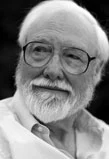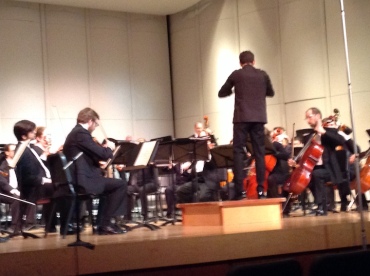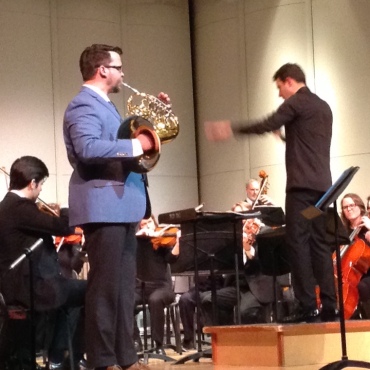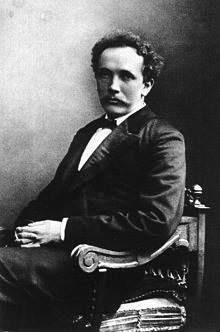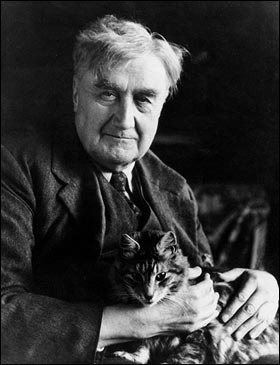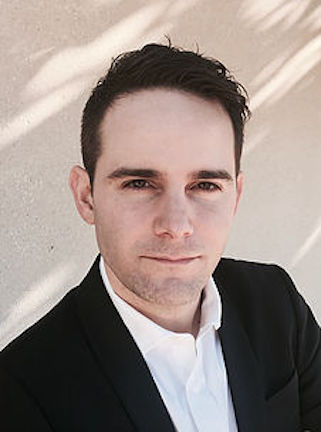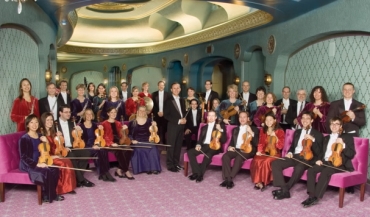The Well-Tempered Ear
Classical music: The Middleton Community Orchestra and UW-Madison horn player Dafydd Bevil excel in a concerto by Richard Strauss and a theater suite by Ralph Vaughan-Williams. Plus, the UW’s Perlman Trio performs Saturday afternoon
4 Comments
ALERT: On SATURDAY – (not today as first mistakenly listed) –at 3:30 p.m. in Morphy Recital Hall, the annual FREE concert by the UW’s Perlman Trio — named after benefactor Kato Perlman — will perform piano trios by Franz Joseph Haydn and Robert Schumann, and a piano quartet by Johannes Brahms. A reception will follow For more information about the student performers and the full program, go to: https://www.music.wisc.edu/event/the-perlman-trio/
By Jacob Stockinger
Here is a special posting, a review written by frequent guest critic and writer for this blog, John W. Barker. Barker (below) is an emeritus professor of Medieval history at the University of Wisconsin-Madison. He also is a well-known classical music critic who writes for Isthmus and the American Record Guide, and who hosts an early music show once a month on Sunday morning on WORT FM 89.9 FM. For years, he served on the Board of Advisors for the Madison Early Music Festival and frequently gives pre-concert lectures in Madison. Barker also took the performance photos.
By John W. Barker
The Middleton Community Orchestra (below), under conductor Kyle Knox, brought off a splendid concert on last Wednesday evening.
The opening item was the Introduction and Allegro, Op. 47, for string quartet and string orchestra by Edward Elgar. This is a broad work of great Romantic sweep, featuring the lush textures pitting a large ensemble against a miniature one.
The largely amateur Middleton orchestra fields a very large string section. It has not yet completely fused into a suave entity, but the 30-odd players did a brave job of capturing the music’s rhetorical richness.
The soloist for the evening was Dafydd Bevil (below), a French horn player who is very active in a number of orchestras and ensembles in the Madison area while currently engaged in doctoral studies at the University of Wisconsin-Madison’s Mead Witter School of Music.
Bevil boldly chose as his vehicle the second of Richard Strauss’ two horn concertos. Neither is heard in concert very much, though the Concerto No. 1 is a little more familiar from recordings. That is a bravura piece, composed in 1882, when Strauss (below) was 18, and was written for his father, Germany’s foremost horn virtuoso.
The Concerto No. 2 dates from the other end of Strauss’s career, in 1942, the first of some wind concertos undertaken during and after World War II. Intended to recapture his earlier instrumental style, it is a much more studied piece than its predecessor.
Bevil, clearly a player of exceptional skill and musicality, powerfully met Strauss’ showy and florid solo writing. This is a virtuoso musician with a promising future.
The remainder of the concert was devoted to the first of what would be a number of scores Ralph Vaughan Williams (below) prepared to fit Classical Greek plays. (RVW was himself a very accomplished master of ancient Greek.)
In 1912, inspired by the translations of Gilbert Murray, he produced music to set Murray’s English texts for three of the plays by Euripides: The Bacchae, Electra, and Iphigenia in Tauris.
Before that, however, in 1909, still early in his career, Vaughan Williams composed incidental music to a production (in Greek) of the comedy by Aristophanes, The Wasps.
From that Aristophanic score, the composer put together an orchestral concert suite of an overture and five incidental numbers. The overture itself has enjoyed some frequency of concert performances, but the full suite is little known to the public over here.
It was a clever stroke of programming that Kyle Knox (below) led the orchestra in the full suite. This is delightful music, full of typical Vaughan Williams whimsy, inventiveness, and cleverness. Sounding simple, it creates balances and details not easy to manage, but Knox and the orchestra performed it with dazzling flair. (You can hear the rarely performed full suite in the YouTube video at the bottom)
This is exactly the kind of enterprise that makes the Madison area’s musical life so stimulating and joyous.
Tags: #AmateurMusicians, #AmericanRecordGuide, #AncientGreece, #AncientGreek, #ClassicalGreece, #ClassicalGreek, #EdwardElgar, #EnglishLanguage, #FranzJosephHaydn, #FrenchHorn, #GilbertMurray, #GreekLiterature, #GreekTragedy, #HornConcerto, #HornMusic, #IncidentalMusic, #IsthmusNewspaper, #JohannesBrahms, #JohnW.Barker, #JohnWBarker, #KatoPerlman, #KyleKnox, #LateRomanticism, #MadisonEarlyMusicFestival, #MeadWitterSchoolofMusic, #MedievalHistory, #MiddletonCommunityOrchestra, #MiddletonWisconsin, #PerlmanTrio, #PianoQuartet, #PianoTrio, #RadioMusic, #RadioShows, #RalphVaughanWilliams, #RichardStrauss, #RobertSchumann, #RomanticMusic, #StringMusic, #StringQuartet, #TheWasps, #UniversityofWisconsin, #UniversityofWisconsin-Madison, #WindMusic, #WorldWarII, #WORT-FM89.9, allegro, amateur, Aristophanes, Arts, balance, brave, bravura, Cello, Chamber music, Classical music, cleverness, comedy, composer, concerto, critic, dazzling, details, doctoral, Early music, earlymusic, English, ensemble, Euripides, father, flair, florid, future, Germany, guest, History, host, incidental music, instrumental, introduction, Introduction and Allegro, Isthmus, Jacob Stockinger, job, Johannes Brahms, John W. Barker, Joy, joyous, large, lecture, lush, Madison, Medieval, Medieval history, miniature, Music, musicians, Orchestra, orchetsras, Overture, performance, photo, production, professor, promising, Radio, rhetoric, rhetorical, richness, Romanticism, score, solo, stimulating, String quartet, strings, studies, style, Suite, symphony, text, texture, translation, United States, University of Wisconsin-Madison School of Music, University of Wisconsin–Madison, vehicle, Viola, Violin, virtuoso, winds, YouTube
Classical music: Mozart’s music requires the rhythms of both speech and dance, says maestro Gary Thor Wedow, who will also restore lost libretto text when he conducts two performances of “The Magic Flute” this weekend for the Madison Opera. Here is Part 2 of his interview with The Ear.
Leave a Comment
By Jacob Stockinger
The Madison Opera will stage Wolfgang Amadeus Mozart’s The Magic Flute this Friday night, April 21, at 8 p.m. and this Sunday afternoon, April 23, at 2:30 p.m. in Overture Hall of the Overture Center. (Production photos are courtesy of the Arizona Opera from which the Madison Opera got the sets and costumes for its production.)
Yesterday’s post was the first of two parts. It has a plot synopsis and links to more information about the cast and production.
Here is a link to Part 1:
The opera runs about 2 hours and 45 minutes with one intermission.
Tickets are $18 to $130.
“The Magic Flute” will be sung in German with English supertitles.
For more about the production and cast, go to:
http://www.madisonopera.org/performances-2016-2017/the-magic-flute/
And also go to:
http://www.madisonopera.org/performances-2016-2017/the-magic-flute/cast/
Here is Part 2 of The Ear’s recent email interview with conductor Gary Thor Wedow (below, conducting in an orchestra pit):
Are there certain “tricks” or “secrets” that you try to bring to conducting Mozart? Have you conducted “The Magic Flute” before? Do Mozart’s operas in general and this opera in specific present challenges? Where do you place the opera musically, both compared to other operas in general and in regard to its place in Mozart’s work?
I feel keenly that Mozart and all 18th-century music (probably continuing to this day) is either based on a rhetorical idea or a dance form; that music is either speaking or dancing. This style of music is “pre-French Revolution,” so No Two Notes are Created Equally! The lilt of language or the buoyancy of the dance has to infuse every moment; hierarchy and shape prevail.
I’ve been fortunate to have conducted The Magic Flute frequently, in many varied productions; it’s always been a part of my musical life. Because it’s a fairy tale, it lends itself to inventive and imaginative productions. Stage director Dan Rigazzi’s production (below) for Madison Opera is a whimsical one, influenced by the surrealist painter Magritte, steampunk and more, all rolled into one beautiful show.
Mozart was fascinated with German Singspiel, as it was opera in the language of the people. The Magic Flute is his masterpiece in this genre, though there are earlier works. There is the early Zaide – incomplete, but filled with gorgeous, innovative music –and also the more mature, sumptuous and comic The Abduction from the Seraglio; they are both rich and entertaining pieces.
The Magic Flute, I feel, has a special place in the opera repertoire for several reasons: its Masonic connections that were very important to Mozart, the drama, and its central themes that trace themselves back to ancient Egypt.
It also is a brilliant combination of comedy and deep spiritual drama in the guise of a heroic rescue tale. It uses an incredibly wide range of the most beautiful music written in every major genre: sacred music, opera seria, bel canto, folk song and complex Baroque counterpoint.
What would you like listeners to pay special attention to in the music of “The Magic Flute”?
I would say “Hang on!” Whatever style of music we are in, we are going to switch gears in a fairly short time. It’s a roller coaster, an Ed Sullivan Show, American Idol, and the Barnum and Bailey Circus all rolled into one.
This is your third time conducting at Madison Opera. Do you have an opinion about Madison musicians and audiences?
My previous two experiences in Madison have been the Opera in the Park concerts in 2012 and 2016 (below). These have been among the most sublimely satisfying moments of my musical life: a cornucopia of music played by this brilliant symphony orchestra with great singers.
The audiences have been magically focused and involved; the players are magnificent, dedicated musicians, and the community is very supportive of Madison Opera. It’s electric.
Is there anything else you would like to say about the music or this performance?
Magic Flute devotees might be startled to hear some new text in these performances, particularly in Tamino, Pamina and Sarastro’s arias and the duet with Pamina and Papageno. “Bei Männern” is now “Der Liebe.” (You can hear it in the YouTube video at the bottom.)
Let me explain by telling you a mystery story. After Mozart died, Constanze was desperate for money. Mozart’s Flute manuscript conducting score belonged to Schikaneder, the librettist and producer, but it seems that Constanze had another original score: the first original manuscript, which she then sold to a nobleman who eventually allowed it to be published.
This must have been a “composing score” that Mozart wrote first, before making the conducting score with the help of his assistant. The text deviates in several sections in notable ways. Probably Schikaneder, perhaps assisted by his Masonic brothers, “improved” the text, but Mozart had already shaped his music to the first text.
In most sections the differences are minimal and the new text was indeed an improvement. But in some cases I feel the original text was what inspired Mozart to write and orchestrate the way he did. Our marvelous singers have generously agreed to make the changes and I think we will all see how it fits the music so much better.
Sadly, Constanze’s manuscript was lost in the wars, but many scholars had already seen it and considered it to be genuine. I love how it shows how fluid the creative process is and how it spurs us to look anew at Mozart’s creative process.
On with the show!
Tags: 18th century, Abduction From the Seraglio, American idol, ancient, aria, Arizona Opera, Arts, Barnum and Bailey, Baroque, bel canto, choral music, circus, Classical music, comedy, community, conductor, Costanze Mozart, costumes, counterpoint, creative process, creativity, dance, drama, duet, Ed Sullivan, Egypt, electric, email, folk song, French Revolution, Gary Thor Wedow, genre, German, heroic, idea, innovative, interview, Jacob Stockinger, Juilliard, Juilliard School, language, libretto, link, Madison, Madison Opera, Madison Symphony Orchestra, Maestro, magic, Magritte, manuscript, Masonic, Masons, money, Mozart, msi, Music, mystery, opera, opera buffo, Opera in the Park, opera serio, Orchestra, Overture Center, painter, People, pit, producer, repertoire, rhetoric, roller coaster, sacred, Schikaneder, score, secrets, sets, show, singer, singspiel, speaking, speech, spiritual, steampunk, story, surrealism, surrealist, symphony, text, The Magic Flute, tricks, United States, University of Wisconsin-Madison School of Music, University of Wisconsin–Madison, vocal music, war, Wisconsin, Wolfgang Amadeus Mozart, YouTube, Zaide
Classical music: Wisconsin Chamber Orchestra concert shows Andrew Sewell is a born Bruckner conductor who uses a smaller orchestra to reveal structure
1 Comment
By Jacob Stockinger
Here is a special posting, a review written by frequent guest critic and writer for this blog, John W. Barker. Barker (below) is an emeritus professor of Medieval history at the University of Wisconsin-Madison. He also is a well-known classical music critic who writes for Isthmus and the American Record Guide, and who hosts an early music show once a month on Sunday morning on WORT FM 89.9 FM. For years, he served on the Board of Advisors for the Madison Early Music Festival and frequently gives pre-concert lectures in Madison.
By John W. Barker
The Wisconsin Chamber Orchestra (below) gave the second concert of its season on Friday evening in the Capitol Theater of the Overture Center.
The program opened with a rarely performed symphony, No. 30 in D Major, K. 202, by Wolfgang Amadeus Mozart. Mozart did not muster in this score anything like the ideas he delivered in his symphonies on either side of this one.
Still, it is an engaging piece, and maestro Sewell always shows great sympathy for the Austrian Classical-era composers of the late 18th century, so the performance was nicely molded.
The guest soloist this time was Croatian-born guitarist Ana Vidovic (below). She was originally scheduled to play the Second Guitar Concerto by Mario Castelnuovo-Tedesco, but for some reason she switched late on to the more substantial Concierto de Aranjuez by the 20th-century Spanish composer Joaquín Rodrigo.
Unfortunately, Vidovic followed other guitarists of today who feel they must fortify their performances with electronic amplification, so she brought her own rig with her. The result was a boomy, hollow sound, completely artificial, pitted in fake balance against the natural world of the orchestral writing that was rendered, by the way, with charm and delicacy.
The composer (below) was very careful about not allowing the orchestra to overwhelm the intimate guitar, and generations of guitar players have been able to perform this and parallel concertos without benefit of sonic hype.
Alas, the combination of technology with egotism! Vidovic is obviously a musician of genuine artistry, but she quite sabotaged her playing by use of this six-string howitzer. And the knobs were still on through an encore, a trivial Cavatina by one Stanley Meyer.
The evening was richly redeemed by the main work. Sewell has, in recent years, been working his way into the symphonies of the 19th century, late Romantic Austrian composer Anton Bruckner—a composer usually tackled by large orchestras. But he has brought off the first two numbered symphonies with aplomb, and now was the turn of the Third.
This is a work with a complex history of versions and revisions. Sewell bravely chose to use the 1874 revision of the original 1873 version, rather than the ill-fated revision of 1877 or the once-standard bowdlerization of 1889.
Sewell could command only 20 string players, but they proved quite sufficient, even with the occasional divisions of the violins. The reduced lushness resulting allowed inner parts to come through, and the rest of the orchestra played magnificently. Sewell understands Bruckner’s individual rhetoric, with its stop-and-start pacings and dramatic shifts between tremendous power and great delicacy.
Sewell (below) is indeed a born Bruckner conductor. The second movement in particular I have never heard played so eloquently. (You can hear the second movement of the 1874 edition in the YouTube video at the bottom.) I don’t know if Sewell plans to probe still further into Bruckner’s symphonies, but I am ready to follow him eagerly if he does.
Far from being put off by the often-maligned music of Bruckner, the very large audience gave the performance a justly deserved standing ovation. This was, I think, a genuine landmark in the WCO’s history.
Tags: American Record Guide, amplification, Ana Vidovic, Arts, Austria, Bruckner, cavatina, chamber orchestra, Classical era, Classical music, Concert, concerto, Concierto de Aranjuez, conductor, critic, Croatia, Early music, electronic, encore, guitar, History, Isthmus, Jacob Stockinger, Joaquin Rodrigo, John W. Barker, landmark, Late Romantic, lecture, lushness, Madisn Early Music Festival, Madison, Maestro, Mario Castelnuovo-Tedesco, Medieval history, Mozart, Music, Music director, Orchestra, Overture Center, pacing, rhetoric, soloist, Stanley Meyer, symphony, United States, University of Wisconsin-Madison School of Music, University of Wisconsin–Madison, Viola, Violin, Wisconsin, Wisconsin Chamber Orchestra, Wolfgang Amadeus Mozart, WORT-FM 89.9, YouTube
- May 2024
- April 2024
- March 2024
- February 2024
- January 2024
- December 2023
- November 2023
- October 2023
- September 2023
- August 2023
- July 2023
- June 2023
- May 2023
- April 2023
- March 2023
- February 2023
- January 2023
- December 2022
- October 2022
- September 2022
- June 2022
- May 2022
- April 2022
- March 2022
- July 2021
- June 2021
- May 2021
- April 2021
- March 2021
- February 2021
- January 2021
- December 2020
- November 2020
- October 2020
- September 2020
- August 2020
- July 2020
- June 2020
- May 2020
- April 2020
- March 2020
- February 2020
- January 2020
- December 2019
- November 2019
- October 2019
- September 2019
- August 2019
- July 2019
- June 2019
- May 2019
- April 2019
- March 2019
- February 2019
- January 2019
- December 2018
- November 2018
- October 2018
- September 2018
- August 2018
- July 2018
- June 2018
- May 2018
- April 2018
- March 2018
- February 2018
- January 2018
- December 2017
- November 2017
- October 2017
- September 2017
- August 2017
- July 2017
- June 2017
- May 2017
- April 2017
- March 2017
- February 2017
- January 2017
- December 2016
- November 2016
- October 2016
- September 2016
- August 2016
- July 2016
- June 2016
- May 2016
- April 2016
- March 2016
- February 2016
- January 2016
- December 2015
- November 2015
- October 2015
- September 2015
- August 2015
- July 2015
- June 2015
- May 2015
- April 2015
- March 2015
- February 2015
- January 2015
- December 2014
- November 2014
- October 2014
- September 2014
- August 2014
- July 2014
- June 2014
- May 2014
- April 2014
- March 2014
- February 2014
- January 2014
- December 2013
- November 2013
- October 2013
- September 2013
- August 2013
- July 2013
- June 2013
- May 2013
- April 2013
- March 2013
- February 2013
- January 2013
- December 2012
- November 2012
- October 2012
- September 2012
- August 2012
- July 2012
- June 2012
- May 2012
- April 2012
- March 2012
- February 2012
- January 2012
- December 2011
- November 2011
- October 2011
- September 2011
- August 2011
- July 2011
- June 2011
- May 2011
- April 2011
- March 2011
- February 2011
- January 2011
- December 2010
- November 2010
- October 2010
- September 2010
- August 2010
- July 2010
- June 2010
- May 2010
- April 2010
- March 2010
- February 2010
- January 2010
- December 2009
- November 2009
- October 2009
- September 2009
- August 2009
Archives
- 2,491,578 hits
Blog Stats
Recent Comments
| Brian Jefferies on Classical music: A major reass… | |
| welltemperedear on What made Beethoven sick and… | |
| rlhess5d5b7e5dff on What made Beethoven sick and… | |
| welltemperedear on Beethoven’s Ninth turns 200… | |
| Robert Graebner on Beethoven’s Ninth turns 200… |
Tags
#BlogPost #BlogPosting #ChamberMusic #FacebookPost #FacebookPosting #MeadWitterSchoolofMusic #TheEar #UniversityofWisconsin-Madison #YouTubevideo Arts audience Bach Baroque Beethoven blog Cello Chamber music choral music Classical music Compact Disc composer Concert concerto conductor Early music Facebook forward Franz Schubert George Frideric Handel Jacob Stockinger Johannes Brahms Johann Sebastian Bach John DeMain like link Ludwig van Beethoven Madison Madison Opera Madison Symphony Orchestra Mead Witter School of Music Mozart Music New Music New York City NPR opera Orchestra Overture Center performer Pianist Piano post posting program share singer Sonata song soprano String quartet Student symphony tag The Ear United States University of Wisconsin-Madison School of Music University of Wisconsin–Madison Viola Violin vocal music Wisconsin Wisconsin Chamber Orchestra wisconsin public radio Wolfgang Amadeus Mozart YouTube